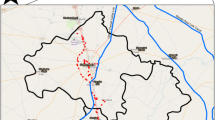Abstract
The present study was carried out in Jhajjar district of Haryana state, India, to understand the burden of diseases due to consumption of contaminated drinking water. About 630 respondents in villages, namely Kablana, Talao, Shekhupur Jat, Hassanpur, Babra and Kheri Asra, were interviewed for the quality of water they consumed from different sources such as government supply stations, hand pumps, tube wells, tanks, etc., and its overall impact on their health was analysed. The study considered both geogenic and anthropogenic contamination in drinking water sources and found that nearly 15% of the sampled population suffered with water-related health issues, of which 6% faced frequent episodes of stomach infection, and 9% were detected with mild to moderate dental fluorosis. Several cases of stones, severe joint pain, and backbone pain were also observed. The average medical expenses incurred by the villagers are in the range of Rs. 1000–2000 per month (approximately $17–$34 per month) for treatment owing to drinking of polluted and contaminated groundwater. Overall finding of the study indicates that unavailability of treated water supply, usage of groundwater with high to very high concentration of geogenic contaminants in groundwater such as fluoride and salinity, and use of water from open surface water resources are causing health problems to people in Jhajjar district. Use of contaminated water is causing economic burden to the villagers in terms of expenditure on health or water treatment by various means, which can be addressed by implementing various in situ and ex situ water management and treatment techniques suggested as intervention options, suitable for the study area.








Similar content being viewed by others
References
Abiye, T., Bybee, G., & Leshomo, J. (2018). Fluoride concentrations in the arid Namaqualand and the Waterberg groundwater, South Africa: Understanding the controls of mobilization through hydrogeochemical and environmental isotopic approaches. Groundwater for Sustainable Development, 6, 112–120.
CGWB. (2007). Ground water scenario in major cities of India. Central Ground Water Board, Ministry of Water Resources, Government of India.
CGWB. (2013). Ground water report Jhajjar District, Haryana. Central Ground Water Board, Ministry of Water Resources, Government of India.
CGWB. (2016). Ground water year book of Haryana State. Central Ground Water Board, Ministry of Water Resources, Government of India.
Craig, L., Thomas, J. M., Lutz, A., & Decker, D. L. (2018). Determining the optimum locations for pumping low-fluoride groundwater to distribute to communities in a fluoridic area in the Upper East Region, Ghana. Chemical Geology, 476, 481–492.
Gulab, (2014). Impact of water logging and salinity on agriculture and socio-economic status in Rohtak and Jhajjar district. International Journal of Resarch Applied Science Engineering Technology, 2(4), 491–497.
Gupta, R., & Misra, A. K. (2016). Groundwater quality analysis of quaternary aquifers in Jhajjar District, Haryana, India: Focus on groundwater fluoride and health implications. Alexandria Engineering Journal. https://doi.org/10.1016/j.aej.2016.08.031.
Jha, B.M., Sinha S.K. (2007). Towards Better Management of Ground Water Resources in India. Central Ground Water Board, Govt. of India.
Khurana I., Sen R. (2008). Drinking water quality in rural India—Issues and Approaches, WaterAid.
Martins, V. T., Pino, D. S., Bertolo, R., Hirata, R., Babinski, M., Pacheco, D. F., et al. (2018). Who to blame for groundwater fluoride anomaly in São Paulo, Brazil? Hydrogeochemistry and isotopic evidence. Applied Geochemistry, 90, 25–38.
Misra, A. K., & Mishra, A. (2006). Groundwater quality monitoring in shallow and deep aquifers in Saidabad tahsil area, Mathura district, India. Environmental Monitoring and Assessment, 117, 345–355.
Raj, D., & Shaji, E. (2017). Fluoride contamination in groundwater resources of Alleppey, southern India. Geoscience Frontiers, 8(1), 117–124.
WHO. (2002). The World Health Report 2002—Reducing risks, promoting healthy life. Geneva: World Health Organization.
Yadav, J. P., & Lata, S. (2003). Urinary fluoride levels and prevalence of dental fluorosis in children of Jhajjar district, Haryana. Indian Journal of Medical Sciences, 57(9), 394–399.
Yadav, J. P., Lata, S., Kataria, S. K., & Kumar, S. (2009). Fluoride distribution in groundwater and survey of dental fluorosis among school children in the villages of the Jhajjar District of Haryana, India. Environmental Geochemistry and Health, 31(4), 431–438.
Author information
Authors and Affiliations
Corresponding author
Rights and permissions
About this article
Cite this article
Gupta, R., Misra, A.K. Drinking water quality problem in Haryana, India: prediction of human health risks, economic burden and assessment of possible intervention options. Environ Dev Sustain 21, 2097–2111 (2019). https://doi.org/10.1007/s10668-018-0125-z
Received:
Accepted:
Published:
Issue Date:
DOI: https://doi.org/10.1007/s10668-018-0125-z




